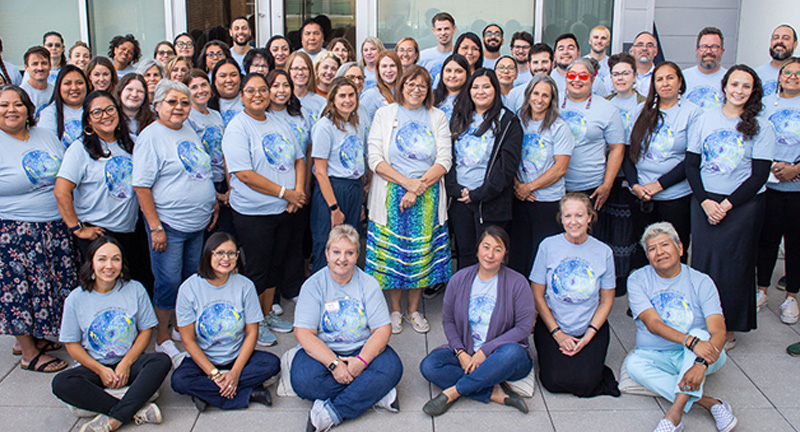Sitting Bull College’s Mobridge Site Offers Community Head-Start in College
May 3, 2012
When Sitting Bull College (SBC) opened a new building for a satellite campus in January, administrators were pleasantly surprised. Nearly four times as many students (45) than in the past enrolled for classes at the tiny site in Mobridge, South Dakota.
A town of 3,465 people, Mobridge is situated near the Standing Rock Reservation, about 50 miles from Sitting Bull College’s main campus in Ft. Yates. The distance makes it difficult for students and potential students to travel during South Dakota’s severe winters.
The college had offered classes in Mobridge before. “We were renting different buildings for classes. It was very expensive and we didn’t have a lot of students attending, so [at the time] we could not justify purchasing a building,” says Dr. Laurel Vermillion, college president. In the fall of 2009, the college stopped offering classes when the school was forced to relocate its classes due to escalating rents and a low enrollment of just 10-12 students each semester.
In 2011, Dr. Vermillion says, “There was an old brick elementary school for sale in Mobridge. Jonathan Anderson, who runs our Tribal Business Information Center (TBIC), took the board down and looked at it. It was $45,000 and we thought that was a good price. It is two floors and has a lot of space; more space than we even need.” The building was purchased using a donation from a long-time benefactor.
Today SBC is holding classes in Mobridge on the main floor of its new building. Vermillion says a decision has not yet been made about how to use the second floor. “We will do some renovations first and then decide whether to rent space to local businesses,” she says.
“We are putting funding and energy into making it a nice place,” Dr. Vermillion says, adding that the fact that residents have a permanent school to call their own may be the cause of increased enrollment.
The Mobridge location offers general education classes, such as English, mathematics, speech, computer sciences, and Lakota language, according to Jan Brockel, the site coordinator. “Next spring 2013, we will offer our first laboratory science course. We will install the lab equipment next fall,” she says. “This is especially attractive to students interested in pursuing a nursing curriculum. A lot of students are interested in nursing because around here nursing pays very well. Students can come to the Mobridge location and get the basics and then complete the courses for their degree in Ft. Yates.”
Mobridge also offers classes over the interactive video network (IVN) for students who want to take additional coursework but do not want to or cannot make the drive to the Ft. Yates campus. According to Dr. Koreen Ressler, Vice President of Academics at SBC, next year professors who teach IVN classes will travel to the other SBC sites to teach, giving students the opportunity to meet with them in-person. Counselor and tutoring services, including 20 hours of GED tutoring, are available at all SBC locations.
The Mobridge branch doesn’t merely save college students a long journey. It also fuels student interest in college by offering dual enrollment courses for high school students.
Dual enrollment allows high school students to take college courses in their senior year of high school that qualify for credit for both higher-level high school and introductory college course credit in subjects such as calculus. In rural reservation areas this is especially important, Dr. Vermillion says, as it is often difficult to attract qualified teachers to teach courses that college-bound students need. She attributes this to the rural nature of the community and limited housing supply.
Another added benefit of dual enrollment programs, according to Jennifer Donnay-Zinth, a senior policy analyst of the Denver, Colorado-based Education Commission of the States, a nonprofit policy research and analysis organization, is that students can complete their general education course requirements for their first year of college while living at home. This saves students money on college housing costs. Although policy varies by state, some states have enacted legislation to ensure parents and students are reimbursed for the cost of tuition for dual enrollment coursework, Donnay-Zinth says.
Dual-enrollment programs can also save low-income students the worry of extinguishing Pell Grant benefits before completing their degree. Changes in the federal student aid programs for 2012-13 have reduced the duration of a student’s eligibility to receive a Federal Pell Grant from 18 semesters (or its equivalent) to 12 semesters (or its equivalent). The duration of a student’s eligibility includes all years of the student’s receipt of Federal Pell Grant funding. As long as students ensure that their credits are transferrable, Donnay-Zinth says dual enrollment programs offers many advantages to students—saving money, shortening the time that students need to be away from home in college, while ensuring students get the advanced-level courses they need to be successful in college while they are in still in high school (where rural or poor school districts may not offer advanced courses).
Tribal colleges are uniquely situated to serve areas where there are no other options for higher education on remote Indian reservations. They also serve local non-Indian populations.
Sitting Bull College is not alone amongst tribal colleges offering dual enrollment.
Tohono O’odham Community College (TOCC), serving the Tohono O’odham Reservation on the U.S./Mexico border in Sells, Arizona directs a community-wide partnership with K-12 schools for college preparation. Students can earn up to nine hours of college credit towards high school graduation. The experience gives students a positive pre-college experience and the Tohono O’odham Nation has seen more students continuing on with their higher education, either at TOCC or other colleges.
Dual enrollment programs also help high school students determine early on if college is for them, Dr. Vermillion said. “It makes them less fearful and gives them a foot in the door, especially first-generation students. It’s really important to make them feel comfortable and experience some success.” Dounay-Zinth says these programs also help eliminate “senioritis,” a time when some students slack off from learning.
Combined with a dual enrollment program, attending a tribal college makes a college education more affordable. Sitting Bull College was named the most affordable college four-year or above college or university in the United States last year by the Department of Education. The Department of Education ranking looked at the net price or average price of attendance that is paid by full-time students after grants and scholarships are taken into account. At Sitting Bull College this amounts to $938 per year for any student, Native or non-Native. Last year (June 2011) was the first year the reports were published, as stipulated in the Higher Education Opportunity Act of 2008.
Rural educators face unique challenges, which are compounded on Indian reservations where there are higher rates of poverty and unemployment. Dr. Vermillion participates on the Standing Rock Education Consortium to learn how SBC can assist with other community educational needs, where she serves with representatives from the nine reservation schools, the tribal education department, and the Head Start program. “We do this to support education throughout the reservation. We need to be aware of what’s going on—the challenges—and help to support each other,” she said.
The Mobridge campus has the typical tribal college student profile, attracting non-traditional, female students, according to Dr. Vermillion. Seventy-six percent are female, 28 are students enrolled full-time and taking 12 or more credits, 12 students are part-time with less than 12 credit hours, and five students are enrolled in less than six credit hours. Eighty percent of the students are Native American and 20 percent are Caucasian. The average age of students taking classes at Mobridge is 28, and 82% are single.
“It’s a pretty neat group of students. We have a student advisory group here and we meet over lunch about student needs, classes offered, and what students and the community want to see at the location,” Brockel says. “One of the things that students really like is the computer lab on location. This is important because many of our students do not have computers or the Internet at home, and this gives them access.”
Brockel’s goal is to have 50% more students next semester than this semester (a targeted 62.5 students). “I also want to keep adding more classes from the bottom up, with more first and second-level courses,” she says. “I also hope to have more going on with the community. We had an art class on Saturdays that was open to the community. A local woman taught it. She is quite an artist and teaches art history,” Brockel says.
Brockel attributes the jump in enrollment to promotion. “We started promoting the location in October and had two months to get the word out. We used traditional radio and newspaper advertisements; I visited a lot of community groups, high schools, city councils, we had a booth at the hospital bazaar, and I was even featured as the cook of the week in the Mobridge newspaper, where I talked about the school in the story,” she says, chuckling. “You get a lot of mileage being the cook of the week in Mobridge. I also had students speak about the school in the community that they would recognize.”
“The Mobridge community is very supportive and encouraging and really likes the fact that there is a place to meet right where their children, family, and community members can attend college. They can stay at home and take classes, they don’t have to go away and rent a room to get an education. It makes college a lot more affordable to take their general education requirements there and hopefully transfer after they have finished to a program at our campus in Ft. Yates. They can use the Standing Rock Transportation Program and ride up to our campus on the buses in the morning, take classes, and go home in the evening. I have been hearing a lot of good things from people there—they are really pleased, they have a site, and it now feels real to them,” Dr. Vermillion says.
Tribal Colleges That Have Offered Dual Enrollment Programs from 2006-Present
- Aaniiih Nakoda College, Harlem, MT
- Bay Mills Community College, Brimley, MI
- Blackfeet Community College, Browning, MT
- Cankdeska Cikana Community College, Fort Totten, ND
- Diné College, Tsaile, AZ
- Fort Berthold Community College, New Town, ND
- Fort Peck Community College, Poplar, MT
- Ilisagvik College, Barrow, AK
- Institute of American Indian Arts, Santa Fe, NM
- Keweenaw Bay Ojibwa Community College, Baraga, MI
- Lac Courte Oreilles Ojibwa Community College, Hayward, WI
- Leech Lake Tribal College, Cass Lake, MN
- Little Priest Tribal College, Winnebago, NE
- Navajo Technical University, Crownpoint, NM
- Northwest Indian College, Bellingham, WA
- Oglala Lakota College, Kyle, SD
- Saginaw Chippewa Tribal College, Mount Pleasant, MI
- Sisseton Wahpeton College, Sisseton, SD
- Southwestern Indian Polytechnic Institute, Albuquerque, NM
- Stone Child College, Box Elder, MT
- Tohono O’odham Community College, Sells, AZ









